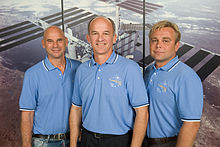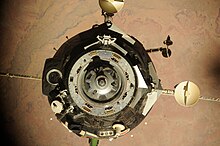 | |
| Mission type | ISS crew rotation |
|---|---|
| Operator | Roskosmos |
| COSPAR ID | 2009-053A |
| SATCAT no. | 35940 |
| Mission duration | 168 days |
| Spacecraft properties | |
| Spacecraft | Soyuz No.226 |
| Spacecraft type | Soyuz-TMA 11F732 |
| Manufacturer | RKK Energia |
| Crew | |
| Crew size | 3 up 2 down |
| Members | Maksim Surayev Jeffrey Williams |
| Launching | Guy Laliberté |
| Start of mission | |
| Launch date | September 30, 2009, 07:14:45 UTC[1][2] |
| Rocket | Soyuz-FG |
| Launch site | Baikonur 1/5 |
| End of mission | |
| Landing date | March 18, 2010, 11:24 UTC[1] |
| Orbital parameters | |
| Reference system | Geocentric |
| Regime | Low Earth |
| Perigee altitude | 340 kilometres (210 mi) |
| Apogee altitude | 351 kilometres (218 mi) |
| Inclination | 51.6 degrees |
| Period | 91.44 minutes |
| Epoch | October 7, 2009[3] |
| Docking with ISS | |
| Docking port | Zvezda aft |
| Docking date | 2 October 2009 08:35 UTC |
| Undocking date | 21 January 2010 10:03 UTC |
| Time docked | 111d 1h 28m |
| Docking with ISS (Relocation) | |
| Docking port | Poisk zenith |
| Docking date | 21 January 2010 10:24 UTC |
| Undocking date | 18 March 2010 08:03 UTC |
| Time docked | 55d 21h 39m |
 From left to right: Laliberté, Williams and Surayev Soyuz programme (Crewed missions) | |
The Soyuz TMA-16 (Russian: Союз TMA-16) was a crewed flight to and from the International Space Station (ISS). It transported two members of the Expedition 21 crew[1] and a Canadian entrepreneur from the Baikonur Cosmodrome in Kazakhstan to the ISS. TMA-16 was the 103rd flight of a Soyuz spacecraft, the first flight launching in 1967. The launch of Soyuz TMA-16 marked the first time since 1969 that three Soyuz craft were in orbit simultaneously.
Guy Laliberté, founder and CEO of Cirque du Soleil, was a Space tourist aboard TMA-16 during its flight to the ISS, paying approximately US$35 million for his seat through the American firm Space Adventures.[4] He returned on board the Soyuz TMA-14 spacecraft left as an emergency vehicle during that previous flight. The Soyuz TMA-16 flight spacecraft flew back to Earth with only two crew members.






